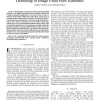Free Online Productivity Tools
i2Speak
i2Symbol
i2OCR
iTex2Img
iWeb2Print
iWeb2Shot
i2Type
iPdf2Split
iPdf2Merge
i2Bopomofo
i2Arabic
i2Style
i2Image
i2PDF
iLatex2Rtf
Sci2ools
TIP
2010
2010
Physically Consistent and Efficient Variational Denoising of Image Fluid Flow Estimates
Imaging plays an important role in experimental fluid dynamics. It is equally important both for scientific research and a range of industrial applications. It is known, however, that estimated velocity fields of fluids often suffer from various types of corruptions like missing data, for instance, that make their physical interpretation questionable. We present an algorithm that accepts a wide variety of corrupted 2-D vector fields as input data and allows to recover missing data fragments and to remove noise in a physically plausible way. Our approach essentially exploits the physical properties of incompressible fluid flows and does not rely upon any particular model of noise. As a result, the developed algorithm performs well and robust for different types of noise and estimation errors. The computational algorithm is sufficiently simple to scale up to large 3-D problems.
2-D Vector Fields | Algorithm | Education | Fluid | TIP 2010 |
Related Content
| Added | 22 May 2011 |
| Updated | 22 May 2011 |
| Type | Journal |
| Year | 2010 |
| Where | TIP |
| Authors | Andrey Vlasenko, Christoph Schnörr |
Comments (0)

